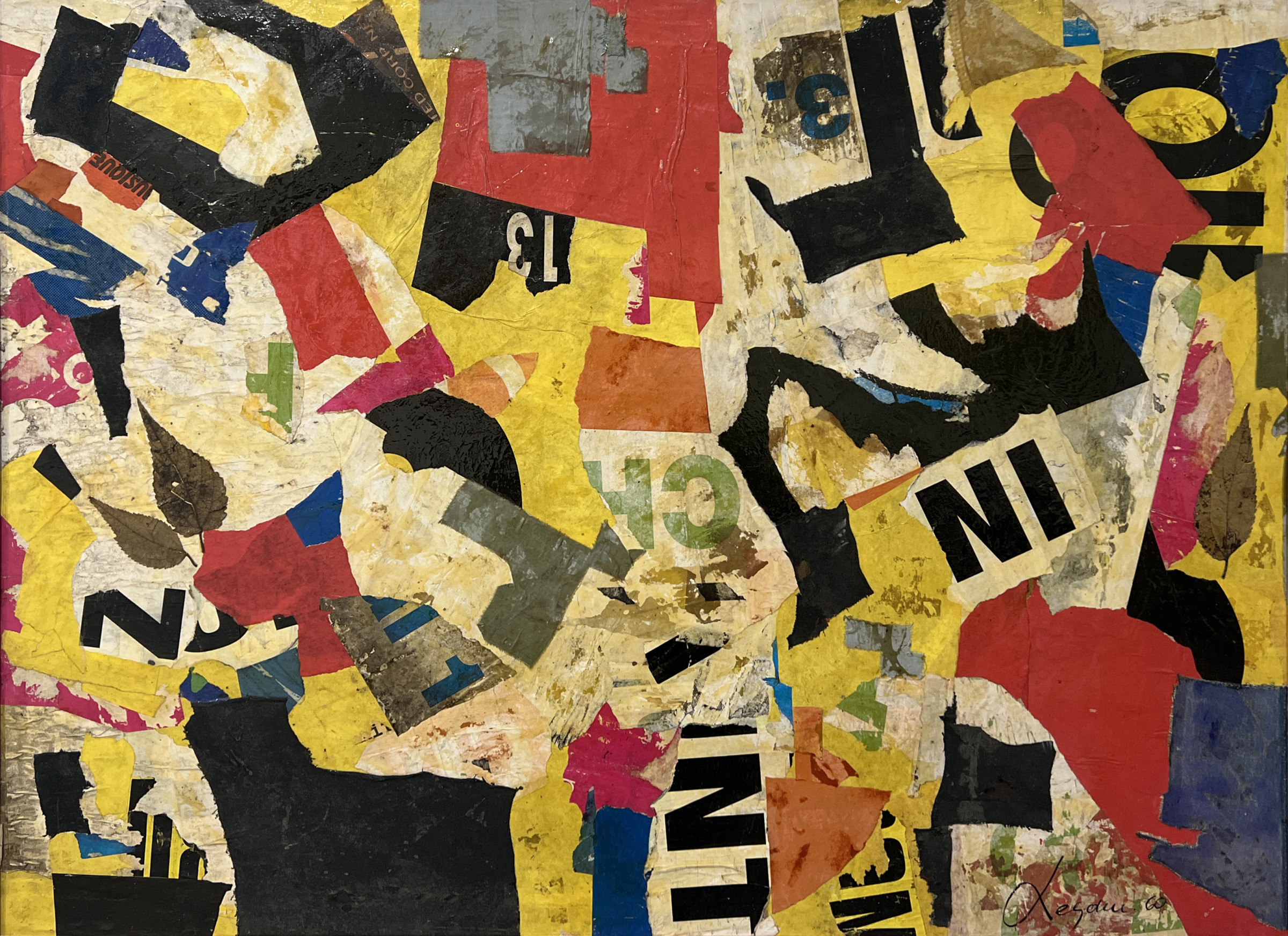Ernest Van Leyden
Rotterdam, 1892 - Montfort-l'Amaury, Francia, 1969
Initially a figurative painter, he devoted himself to abstractionism from the 1950s onwards. Art historians and critics Herbert Read, Gindertael and Michel Ragon took a great interest in his work. The latter wrote: "Van Leyden's painting has a rare quality, which might seem unfashionable and somewhat shocking: it is beautiful. An aggravating circumstance: it is beautiful and joyful".
Ernst Van Leyden was a student at the Academy of Fine Arts in Rotterdam. In 1916 he met Mondrian, Van Doesburg, Van der Leck and the young Willem de Kooning visited him in his atelier.
He traveled to Loosdrecht (near Amsterdam) and also made trips around the Mediterranean: Morocco, Egypt, Sicily, Syria, from which he reports a series of landscapes. He stayed in Paris, where he settled in 1928, and later in Sintra, Portugal, with his future wife Karin, an artist and painter. In 1935 a fire in the London atelier destroyed much of his work. World War II forced him and his wife into exile in the United States, first in New York City and later near Los Angeles. He frequented writers and musicians, to whom he made portraits: Thomas Mann, Henri Miller, Aldous Huxley, Brecht, Dali, Stravinsky. In 1958 he decided to return to live in Paris, in the area of Montfort l'Amaury where he settled permanently.
Van Leyden participated in the 1932 Venice Biennale, in 1935 at the Universal Exhibition in Brussels where he won a gold medal and in 1961 at the Salone delle Nouvelles Realités.
In the 1920s he participated with solo exhibitions at La Haye, Utrecht, Rotterdam, Anvers, Brussels, New York, Paris (Bernheim-Jeune Gallery, Georges Bernheim Gallery, Zak Gallery), in 1935 Lisbon and London and in 1937 Amsterdam. During and after the Second World War, he made himself known in the United States: in 1940 in New York at the Vivienne Gallery, in Los Angeles, in San Francisco... and then again in 1949 in Brussels at the Museum of Fine Arts and in 1959 in Paris at the Suffrene Gallery. From 1962 Ernst Van Leyden continued to exhibit the best-known exhibitions at the Iris Clert Gallery in Venice, Creuse Gallery and Anderson-Meyer Gallery in Paris and the Whitney Museum in New York.
In 1988 and 1989 the Arnoux Gallery in Paris exhibited works by the artist of the fifties and sixties.
From the 1950s, he devoted himself to abstraction. Historians and art critics, Herbert Read, Gindertael and Michel Ragon have been very interested in his works. The latter wrote: "Van Leyden’s painting has a rare quality, which may seem out of date and a little shocking: it is beautiful. Aggravating circumstances: it is beautiful and joyful.".
Museums:
The Hague, France
Anvers
Utrecht, Netherlands
Amsterdam
Rotterdam
Bruxelles (Fine Arts Museum), Belgium
New York (Vivienne Gallery, Whitney Museum)
Paris (Gallery Bernheim-Jeune, Gallery Georges Bernheim, Gallery Zak, Gallery Suffrene, Gallery Creuse, Gallery Anderson-Meyer, Gallery Arnoux)
Lisbon, Portugal
London, United Kingdom
Los Angeles, California
San Francisco
Venice (Gallery Iris Clert), Italy
Bibliography:
E. Bénezit, Dictionnaire critique et documentaire des Peintres, Sculpteurs, Dessinateurs et Graveurs, Paris, Librairie Gründ, 1976
Van Leyden, exhibition catalogue curated by Galleria Lorenzelli, Milan, Milano, 1962
He traveled to Loosdrecht (near Amsterdam) and also made trips around the Mediterranean: Morocco, Egypt, Sicily, Syria, from which he reports a series of landscapes. He stayed in Paris, where he settled in 1928, and later in Sintra, Portugal, with his future wife Karin, an artist and painter. In 1935 a fire in the London atelier destroyed much of his work. World War II forced him and his wife into exile in the United States, first in New York City and later near Los Angeles. He frequented writers and musicians, to whom he made portraits: Thomas Mann, Henri Miller, Aldous Huxley, Brecht, Dali, Stravinsky. In 1958 he decided to return to live in Paris, in the area of Montfort l'Amaury where he settled permanently.
Van Leyden participated in the 1932 Venice Biennale, in 1935 at the Universal Exhibition in Brussels where he won a gold medal and in 1961 at the Salone delle Nouvelles Realités.
In the 1920s he participated with solo exhibitions at La Haye, Utrecht, Rotterdam, Anvers, Brussels, New York, Paris (Bernheim-Jeune Gallery, Georges Bernheim Gallery, Zak Gallery), in 1935 Lisbon and London and in 1937 Amsterdam. During and after the Second World War, he made himself known in the United States: in 1940 in New York at the Vivienne Gallery, in Los Angeles, in San Francisco... and then again in 1949 in Brussels at the Museum of Fine Arts and in 1959 in Paris at the Suffrene Gallery. From 1962 Ernst Van Leyden continued to exhibit the best-known exhibitions at the Iris Clert Gallery in Venice, Creuse Gallery and Anderson-Meyer Gallery in Paris and the Whitney Museum in New York.
In 1988 and 1989 the Arnoux Gallery in Paris exhibited works by the artist of the fifties and sixties.
From the 1950s, he devoted himself to abstraction. Historians and art critics, Herbert Read, Gindertael and Michel Ragon have been very interested in his works. The latter wrote: "Van Leyden’s painting has a rare quality, which may seem out of date and a little shocking: it is beautiful. Aggravating circumstances: it is beautiful and joyful.".
Museums:
The Hague, France
Anvers
Utrecht, Netherlands
Amsterdam
Rotterdam
Bruxelles (Fine Arts Museum), Belgium
New York (Vivienne Gallery, Whitney Museum)
Paris (Gallery Bernheim-Jeune, Gallery Georges Bernheim, Gallery Zak, Gallery Suffrene, Gallery Creuse, Gallery Anderson-Meyer, Gallery Arnoux)
Lisbon, Portugal
London, United Kingdom
Los Angeles, California
San Francisco
Venice (Gallery Iris Clert), Italy
Bibliography:
E. Bénezit, Dictionnaire critique et documentaire des Peintres, Sculpteurs, Dessinateurs et Graveurs, Paris, Librairie Gründ, 1976
Van Leyden, exhibition catalogue curated by Galleria Lorenzelli, Milan, Milano, 1962
